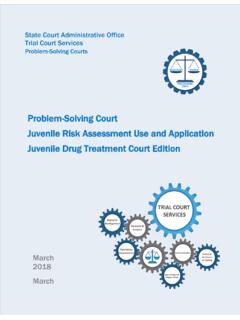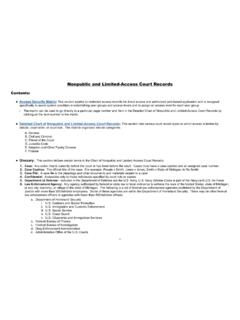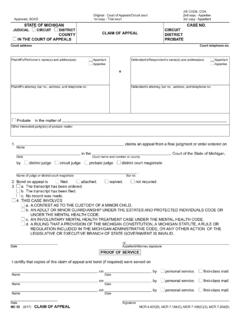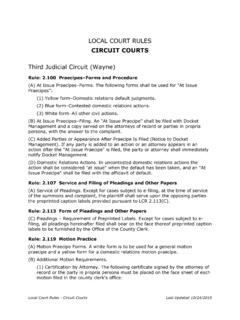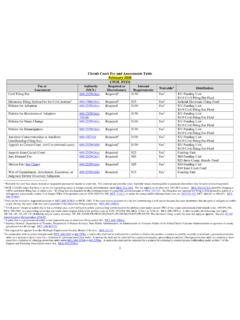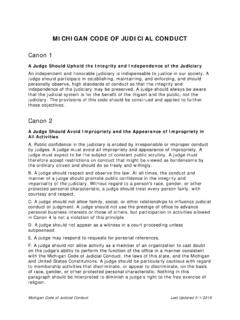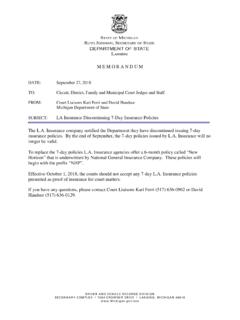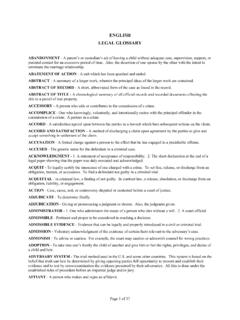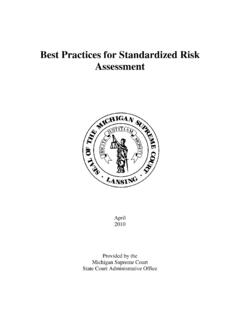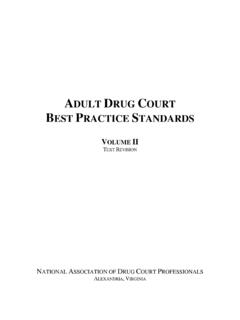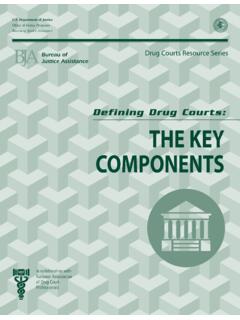Transcription of State Court Administrative Office Court Services Problem ...
1 1 State Court Administrative Office Court Services Problem -Solving Courts Michigan association of treatment Court Professionals Adult Drug Court Standards, Best Practices, and Promising Practices March 2021 INDEPENDENCE ACCESSIBILITY ENGAGEMENT EFFICIENCY i Introduction Purpose This manual was written by staff from the State Court Administrative Office and board members of the Michigan association of treatment Court Professionals. It is designed to assist Michigan s adult drug and DWI courts in complying with the drug Court statute,1 best practices, the 10 Key Components of Drug Courts, and the 10 Guiding Principles of DWI Courts. The content in this manual comes from many sources, but it leans most heavily on statute and the National association of Drug Court Professionals Adult Drug Court Best Practice Standards, Volume I and Volume II.
2 The manual pulls important pieces from all of these sources in order to best represent Michigan s practices. This manual is intended for all adult drug Court team members, and the team should use it to ensure that their program is following the statute and implementing best practices. Definitions The chapters in this manual include three types of information: Standard: Standards are from the drug Court statute, the 10 Key Components, the 10 Guiding Principles, federal and State confidentiality laws, and case law and other precedent that are binding on Michigan courts. Best Practice: Best practices are supported by scientific research and data or nonbinding case law, and are proven methods to follow. The best practices have either been shown by empirical research to produce better outcomes than other practices or they are regarding compliance with confidentiality, due process, or other rules.
3 Their use results in higher-quality programs. Promising Practice: Promising practices are not yet supported by scientific research or data, but anecdotal evidence and experience suggest they are helpful in adhering to the model. Promising practices are recommendations for courts to follow to operate a higher-quality program. 1 See Appendix A. ii How to Use This Manual Each chapter is divided into relevant topics. Included within each topic are the standards, best practices, and promising practices, as well as the supporting authority or research. Not all topics have all three subdivisions; some topics have only best practices while some do not have promising practices. There are two kinds of best practices in this manual: best practices that a program must follow in order to become a certified drug Court (bolded) and best practices that a program should be following.
4 There are footnotes throughout the manual that refer to additional research. The 15 appendices are referenced in the chapters, including model documents that courts can use to comply with certain standards and required best practices. If you would like to request training or technical assistance, please contact your regional administrator. If you have questions, please contact Certification In order for a program to become a certified adult drug Court under MCL , it must comply with the standards and required best practices in this manual. All standards and required best practices are in bold. iii Chapter 1: Roles and Responsibilities of the Drug Court Judge .. 1 I. General .. 1 A. Standards .. 1 B. Best Practices .. 1 II. Staffing Meetings and Review Hearings .. 2 A. Standards .. 2 B. Best Practices .. 2 III. Works Cited .. 4 Chapter 2: Participant Supervision and Compliance.
5 5 I. Caseload .. 5 A. Best Practices .. 5 B. Promising Practices .. 6 II. Monitoring and Review Hearings .. 6 A. Standards .. 6 B. Best Practices .. 6 C. Promising Practices .. 7 III. Services to Participants .. 7 A. Standards .. 7 B. Best Practices .. 7 IV. Ignition Interlock .. 8 A. Standards .. 8 B. Best Practices .. 9 V. Incentives and Sanctions .. 9 A. Standards .. 9 B. Best Practices .. 9 C. Promising Practices .. 11 VI. Payments .. 11 A. Standards .. 11 VII. Phase Promotion and Graduation .. 12 A. Best Practices .. 12 VIII. Program Discharge .. 13 A. Standards .. 13 B. Best Practices .. 13 IX. Works Cited .. 15 Chapter 3: Confidentiality .. 17 iv I. Confidentiality .. 17 A. Standards .. 17 B. Best Practices .. 20 II. Works Cited .. 22 Chapter 4: Due Process .. 23 I. Waiver of Rights .. 23 A. Standards .. 23 II. 1st Amendment .. 23 A.
6 Standards .. 23 B. Best Practices .. 24 III. 4th Amendment .. 24 A. Best Practices .. 24 IV. 14th Amendment .. 25 A. Standards .. 25 V. Sanctions and Termination .. 25 A. Best Practices .. 25 VI. Works Cited .. 27 Chapter 5: The Drug Court Team .. 28 I. Team Composition .. 28 A. Standards .. 28 B. Best Practices .. 28 C. Promising Practices .. 29 II. Staffing Meetings and Review Hearings .. 30 A. Best Practices .. 30 III. Communication and Decision Making .. 30 A. Best Practices .. 30 IV. Works Cited .. 32 Chapter 6: Drug Court Population and 33 I. 33 A. Standards .. 33 B. Best Practices .. 34 II. Eligible Offenses .. 34 A. Standards .. 34 B. Best Practices .. 35 III. Clinical Substance Use and Mental Health Assessments .. 35 v A. Standards .. 35 B. Best Practices .. 36 IV. Risk and Need Assessment .. 36 A. Best Practices .. 36 V. Legal Outcome.
7 38 A. Standards .. 38 VI. Admission Factors .. 39 A. Standards .. 39 B. Best Practices .. 39 VII. Findings on the Record or in the Court File .. 40 A. Standards .. 40 VIII. Program Entry .. 40 A. Best Practices .. 40 IX. Transfers .. 41 A. Standards .. 41 B. Promising Practices .. 42 X. Works Cited .. 43 Chapter 7: Drug and Alcohol Testing .. 45 I. General .. 45 A. Best Practices .. 45 II. Randomization .. 45 A. Standards .. 45 III. Frequency and Breadth of Testing .. 46 A. Standards .. 46 B. Best Practices .. 46 IV. Scientifically Valid Drug Testing Methods .. 47 A. Best Practices .. 47 V. Witnessed Collection .. 49 A. Best Practices .. 49 VI. Chain of Custody and Results .. 51 A. Standards .. 51 B. Best Practices .. 51 C. Promising Practices .. 51 VII. Works Cited .. 52 Chapter 8: treatment .. 54 vi I. General and Definition of Drug treatment Courts and DWI Courts.
8 54 A. Standards .. 54 B. Best Practices .. 54 II. treatment Entry .. 55 A. Best Practices .. 55 III. treatment Services .. 55 A. Standards .. 55 B. Best Practices .. 56 IV. Evidence-Based Models of treatment .. 57 A. Best Practices .. 57 V. treatment Duration .. 58 VI. Medication-Assisted treatment .. 58 A. Best Practices .. 58 VII. Works Cited .. 60 Chapter 9: Education .. 61 I. General .. 61 A. Standards .. 61 B. Best Practices .. 61 II. Works Cited .. 63 Chapter 10: Program Evaluation .. 64 I. Collection and Maintenance of Information .. 64 A. Standards .. 64 B. Best Practices .. 66 II. Evaluation and Program Modification .. 66 A. Best Practices .. 66 B. Promising Practices .. 68 III. Works Cited .. 70 Chapter 11: Equity and 71 I. Equity and Inclusion .. 71 A. Best Practices .. 71 II. Works Cited .. 74 Appendix A Michigan Drug Court Statute.
9 76 Appendix B Model Drug Court Discharge Statement .. 91 Appendix C Model Multi-Party Consent for Release of Information .. 92 Appendix D New Staff and Team Member Orientation .. 97 vii Appendix E Model Confidentiality Policies and Procedures .. 99 Appendix G Model Confidentiality MOU .. 107 Appendix H Model Visitor Confidentiality and Consent for Release of Information .. 115 Appendix I Model Program MOU .. 120 Appendix J Model Drug Court Agreement to Participate and Waiver .. 129 Appendix K Model Program Violation and Advice of Rights .. 132 Appendix L Drug Court Admission 134 Appendix M Model MOU for Transfer of Jurisdiction Under MCL 136 Appendix N Ten Principles of a Good Testing Program .. 138 Appendix O Minimum Standard Data .. 139 1 Chapter 1: Roles and Responsibilities of the Drug Court Judge This chapter discusses the judge s roles on a drug Court team.
10 The judge serves as the leader of the team and plays an important part in guiding participants through the program. Specific topics include the term as a drug Court judge, staffing meetings, and review hearings. Confidentiality is mentioned, but discussed in further detail in Chapter 3. The judge is also important in ensuring participants due process rights are protected; best practices regarding due process are discussed in Chapter 4. I. General A. Standards 1. A drug treatment Court shall comply with the 10 key components promulgated by the national association of drug Court professionals, which include all of the following essential characteristics: Ongoing close judicial interaction with each participant and supervision of progress for each participant. (MCL (c)(vii))2 2. An independent and honorable judiciary is indispensable to justice in our society.
